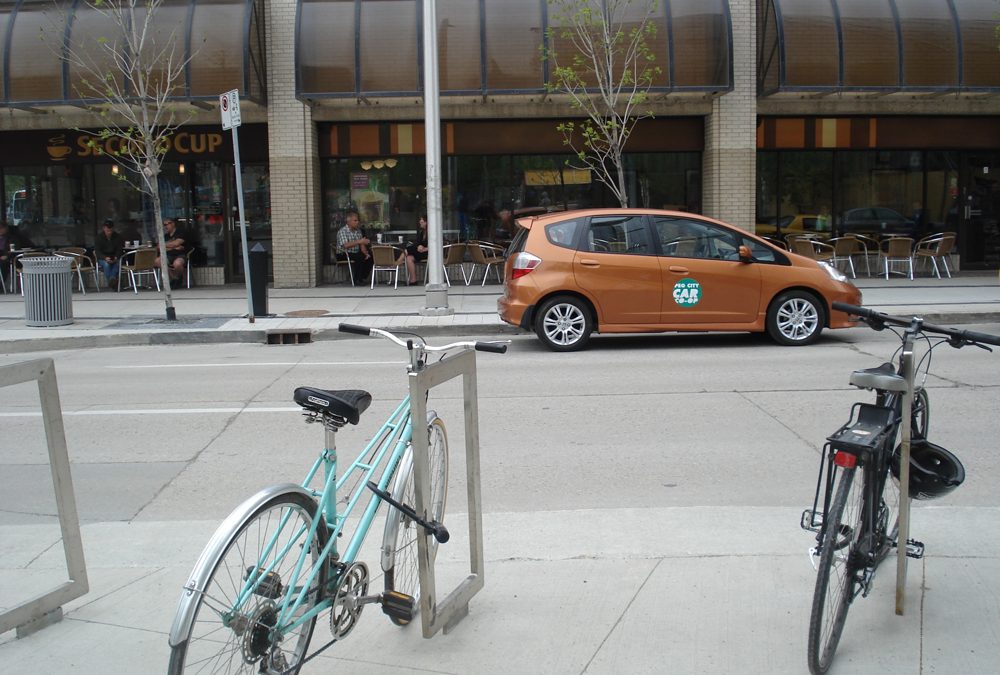Protecting our environment by reducing our reliance on fossil fuels is crucial in combating climate change. Not only will you be protecting your future (and the future of your family and friends), but with many of these, you will also be saving money.
Here are a few things you can do:
1. Choose active modes of transportation
Biking and walking are important for your personal health and the health of our environment. Did you know that people who use active modes of transportation are happier, healthier, and more productive?
2. Take the bus
Busing is a great way to get from point A to point B as it gives you extra time to read a book, check your social media, or even take a nap. A bus pass is cheaper than owning a car (and typically cheaper than a monthly parking pass), and uses much less fuel per person than travelling by car.
3. Find a carpool partner
Busing, biking, or walking not great options for you? Find a carpool partner to reduce the number of trips you are taking. Check out GoManitoba to find regular commuting partners, as well as partners to carpool with for single-trips.
4. Avoid flying as much as possible
Flying requires much more fossil fuel consumption than any other mode of transportation. Choosing the train or a vehicle (of course, carpooling if possible) are crucial considerations when travelling.
5. Use less plastic
Did you know that plastic is made out of fossil fuels? By choosing reusable options for your packing and storage, you are choosing to shift away from a reliance on fossil fuels.
6. Choose car-sharing over owning your own car
By joining a car-share rather than owning your own vehicle, you are required to do more thinking/planning when taking a vehicle (eg. you’re likely going to choose cycling, walking, or busing when making a quick trip to the grocery store). You’re ensuring less cars are on the road, less cars are being manufactured, and you’re saving money! Psst…the carbon tax hasn’t influenced Peg City Car Co-op prices.
7. Seal up all windows and doors
Don’t let the frigid cold enter your home. Find where unnecessary air is entering your home and seal up those spots.
8. Install high-efficiency furnace
Installing a new furnace? Ensure it’s high-efficiency. Even better, get one that’s powered by hydro-electricity rather than gas. On average, gas furnaces emit 1000kg of pollution whereas hydro furnaces only emit 25kg.
9. Choose geothermal or wood fireplace as a heat source
Geothermal and wood burning fireplaces produce fewer carbon emissions than natural gas.
10. Use a programmable thermostat
By installing a programmable thermostat, you ensure you aren’t unnecessarily heating/cooling your home while you’re away (or asleep).
11. Consolidate errands and shop closer to home
Doing errands on a bike or using public transit is ideal. But we understand that sometimes, using a car is the most logical option. In that case, choose to shop close to home and do all your errands at once to avoid taking an extra trip.
12. Avoid driving during rush hour
Really need to use a car for something? Do everything you can to avoid driving during rush hour. Idling in traffic isn’t good for your mental health or our environment.
13. Eat local food
Think about how far your food traveled to get to your plate and remember that with each kilometer, additional fossil fuels were used. Choose local, sustainable food to cut down your carbon footprint.
14. Avoid “rush” shipping
Tempted by the “receive your shipment in 24 hours” promotion? Depending where the product is coming from, that likely means a plane is involved in getting your shipment to you. By waiting to receive your product, it is more likely to arrive via land than air, cutting down on carbon emissions.
15. Eat less meat
Production of meat and dairy emits copious amounts of greenhouse gases. When looking at ways to reduce your carbon footprint, reducing the amount of meat you’re eating is key. If you are eating meat, choose pork and chicken over beef.
16. Don’t idle
Sitting somewhere for more than 10 seconds? Turn your car off. Tempted to warm your car up before you drive? It’ll actually warm up faster by driving. Ease into the drive (rather than revving) to protect our planet and your car.
17. Adjust layers of clothing instead of adjusting the thermostat
Just because you’re cold (or warm) doesn’t mean you need to adjust your thermostat. Add or remove layers of clothing to save money and reduce energy use.
18. Insulate your attic and basement
Cool (and warm) air seeps in through more than just cracks in your windows and doors. Ensuring your entire home is insulated can go along way in avoiding unnecessary heat loss.
19. Protest against further fossil fuel infrastructure
Additional fossil fuel infrastructure is bad for our planet (and a waste of money). Talk to your municipal, provincial, and federal leaders to ensure the mitigation of further fossil fuel infrastructure. Contact the Manitoba Energy Justice Coalition for more information.
20. Divest from fossil fuel investments
Do you have investments in fossil fuel infrastructure? Divest! As we move to a green economy, there are plenty of alternative investments you can look into that are much less harmful on our planet.
21. If driving, choose a small, fuel efficient vehicle
We’re not telling you to go out and buy a new car. Ultimately, we want you to choose busing, cycling, and walking over anything. But if these aren’t options for you, be sure your vehicle is small and fuel-efficient.




Hey, Bethany, what does carpool utilize to run its engine? is it an eco-friendly alternate to fossil fuel?
Unless you happen to carpool using an electric vehicle, fossil fuels are still involved. However, as opposed to driving a car per person, you’re still cutting down on GHG emissions by reducing the number of cars on the road!